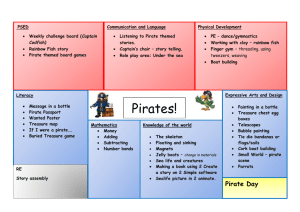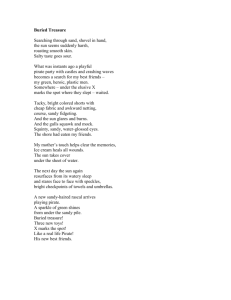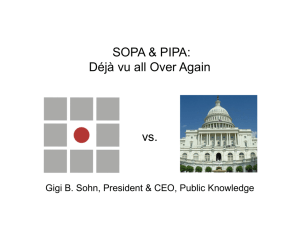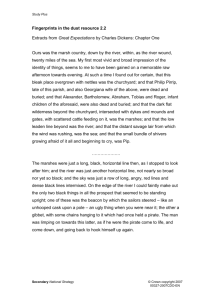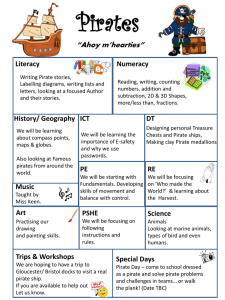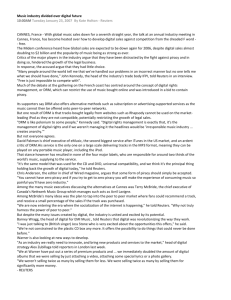Information Technology in Business and Society
advertisement
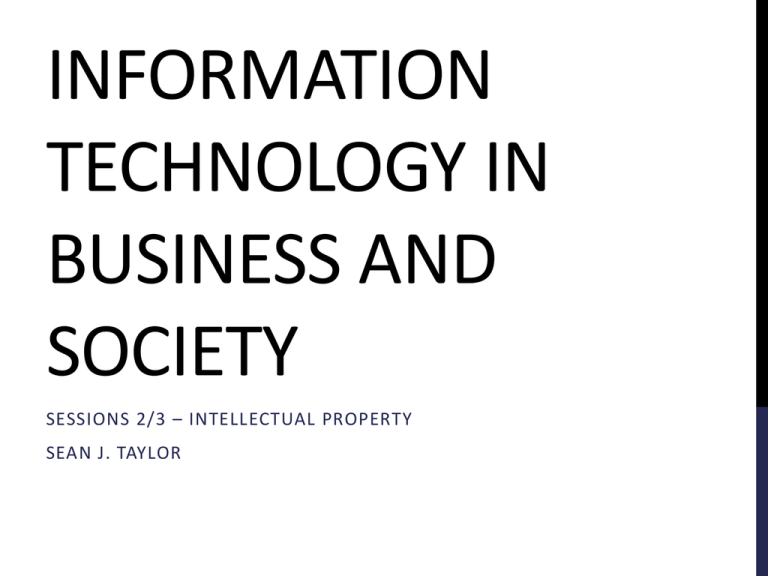
INFORMATION TECHNOLOGY IN BUSINESS AND SOCIETY SESSIONS 2/3 – INTELLECTUAL PROPERTY SEAN J. TAYLOR AMINISTRATIVIA • Office hours today: 3:30-5:30 in KMC 8-191 • Varun’s office hours: 3-5pm on Monday in 8th Floor tutoring area • Pick up any missed handouts outside my office: 8-186 • We will form groups in a few weeks. Don’t worry about that now. • I will be posting lecture notes on the website. • Thanks for the emails! WHAT’S THIS CLASS ABOUT? OUTLINE Why do we have IP laws? A brief history of Copyright law in the US Fair Use Analog vs. Digital What has IT changed? Piracy Theory DRM and DMCA SOPA New Business Models? WHAT IS (INTELLECTUAL) PROPERTY? WHY DO WE HAVE IP LAW? GOOD ARTISTS COPY. GREAT ARTISTS STEAL. ORIGINAL WORKS OF AUTHORSHIP THAT ARE FIXED IN TANGIBLE FORM OF EXPRESSION. The primary objective of copyright is not to reward the labour of authors, but “[t]o promote the Progress of Science and useful Arts.” To this end, copyright assures authors the right to their original expression, but encourages others to build freely upon the ideas and information conveyed by a work. This result is neither unfair nor unfortunate. It is the means by which copyright advances the progress of science and art. –Justice Sandra Day O’Connor (1991) Before: protection only for published works with © attached, otherwise public domain After: protection for original works which are fixed in a tangible medium of expression 1. 2. 3. 4. 5. REPRODUCE CREATE DERIVATIVE WORKS SELL, LEASE, OR RENT PERFORM PUBLICLY DISPLAY PUBLICLY BUT NO RIGHT TO UNDERLYING IDEA IS GRANTED. IT’S IN THE PUBLIC DOMAIN. OWNER BUYER Cannot copy the work without permission… LICENSE SALE FAIR USE ANY COPYING OF COPYRIGHTED MATERIAL DONE FOR A LIMITED AND “TRANSFORMATIVE” PURPOSE SUCH AS TO COMMENT UPON, CRITICIZE OR PARODY A COPYRIGHTED WORK. SUCH USES CAN BE DONE WITHOUT PERMISSION FROM THE COPYRIGHT OWNER. 1. WHAT IS THE NATURE OF THE USE? • Personal, Nonprofit, Educational OK! • Criticisim, Commentary • Parody • Transformative/Remix • Commercial INFRINGMENT 2. WHAT IS THE NATURE OF THE WORK? • Fact, published OK! • Imaginative • Unpublished INFRINGMENT 3. HOW MUCH OF THE WORK IS USED? • Four notes OK! • Sample the whole song INFRINGMENT 4. EFFECT OF THE USE ON THE MARKET FOR THE ORIGINAL WORK • Complementary work OK! • Perfect substitute INFRINGMENT RIGHT OR DEFENSE? analog digital SAMPLING: FROM ANALOG TO DIGITAL AN ANALOG COMPUTER ANALOG COPYING EFFECT OF IT? 1. DIGITIZATION 2. MODULARITY 3. COMPUTING POWER 4. CONNECTIVITY A model of piracy Value of product buyers price non-buyers Cost of pirating A model of piracy Value of product pirate non-consumers Cost of pirating A model of piracy Value of product pirate buyers price pirate non-consumers non-consumers Cost of pirating A model of piracy: easier to pirate Value of product pirate buyers price pirate non-consumers non-consumers Cost of pirating A model of piracy: adding DRM or enforcement Value of product pirate new buyers old buyers price pirate non-consumers non-consumers Cost of pirating A model of piracy: lower the price! Value of product pirate new buyers old buyers price new buyers pirate non-consumers Cost of pirating AMINISTRATIVIA • Pick up any missed handouts outside my office: 8-186 • Posting to the course blog • Participate in social media experiment! • http://apps.facebook.com/shopperquiz • Assignment 1 is pushed back one week. • Handed out in 1 week (2/7) • Due 2/14, will cover IP and IT Strategy THIS CLASS 1. DRM and DMCA 2. SOPA 3. Software Patents DRM Technology to limit the use of digital content after sale. Methods: • Encrypt content and allow access with decryption hardware or software. • Embed digital fingerprints on content so that source of piracy can be detected. Usually a substantial investment for producers, and a hassle for users! THE ANALOG HOLE CRACKED DMCA: CRACKING DRM IS ILLEGAL Passed in 1998, signed into law by President Clinton Implements treaties signed in 1996 at the World Intellectual Property Organization (WIPO) Supported by software and entertainment industries vs “We hold that one who distributes a device with the object of promoting its use to infringe copyright, as shown by clear expression or other affirmative steps taken to foster infringement, is liable for the resulting acts of infringement by third parties.” DMCA’S ANTI-CIRCUMVENTION UNINTENDED CONSEQUENCES? A threat to research / security? • SDMI and Professor Edward Felten’s research group • Researchers can’t inform consumers about security flaws. A threat to fair use? • Fair use tools banned: DVD playing/copying software • Time/space/format-shifting impossible without circumvention A threat to innovation and competition? vs • Real develops “Harmony” technology • Allows iPod owners to buy songs from Real’s Music Store and play them on their iPods • Costly reverse engineering effort • How does the DMCA apply? DRM IN THE FUTURE? DMCA TITLE II: OCILLA Online Copyright Infringement Liability Limitation Act Creates conditional “safe harbor” for online service providers (OSPs) • Can make temporary copies to transmit them • Not liable for infringement of your users! vs • Complaint: over 150,000 unauthorized clips viewed 1.5B times • YouTube deliberately built up a library of infringing works in order to increase site traffic HOW TAKE DOWN WORKS 1. Jack puts content under Jill’s copyright on YouTube 2. Jill notices this. 3. Jill’s lawyer sends a letter to YouTube’s designated agent detailing the infringement. 4. YouTube MUST take the video down and tell Jack. 5. Jack can send a counter-notice to YouTube to have the content “Put Back” 6. If Jill doesn’t file a lawsuit within 14 days, YouTube must put the material back up. SOPA GOALS 1. Protect IP of content creators 2. Protect against counterfeit drugs (what?!) Key Definition: Site dedicated to theft of US Property “Engages in, enables or facilitates…” SOPA: ENFORCEMENT SOPA: ENFORCEMENT II Enables US Gov’t to block access to entire sites if they meet the criteria. 1. Rights holders notify ISPs and say “this site is a site dedicated to the theft of US property” 2. ISPs immediately block access to the site. 3. Site can provide counter-notification explaining how it is not in violation. 4. Rights-holder can sue infringing sites AND ISPs who refuse to comply. • The end of “safe harbor” • Guilty until proven innocent. SOPA POTENTIAL EFFECTS Upstream/Downstream? OBSOLETE BUSINESS MODELS? PATENTS The right to exclude others from making, selling, or using an invention. • Most comprehensive form of IP protection • Even using independent discovery of same invention is excludable. Criteria 1. Useful 2. Novel 3. Nonobvious FAMOUS/CONTROVERSIAL IT PATENTS 1. Amazon: 1-Click 2. Priceline.com: Reverse auctions over a communications network 3. OpenMarket: Electronic Shopping Carts 4. McAfee: Software as a web service 5. Netcentive: Online incentive and loyalty programs vs • BN.com’s use of the 1-click feature was challenged by Amazon.com • Injunction: BN prevented from using 1-click from 1999-2001 • Settled under confidential terms vs • Priceline claims Expedia’s “name your own price” feature infringes on “Internet-based reverse auctions” patent. • Expedia now pays royalties to Priceline. PATENTS: STILL RELEVANT? • Mutually assured destruction? • Defensive only. • Startups say that they are not important for competitive advantage. • The right incentives? How would you change the system? If you had a startup, would you seek patents? PATENT TROLLS LARRY LESSIG’S “THE FUTURE OF IDEAS” NEXT CLASS: IT FIRM STRATEGY • Review Porter’s Framework • Read first chapter of “The Innovator’s Dilemma”
